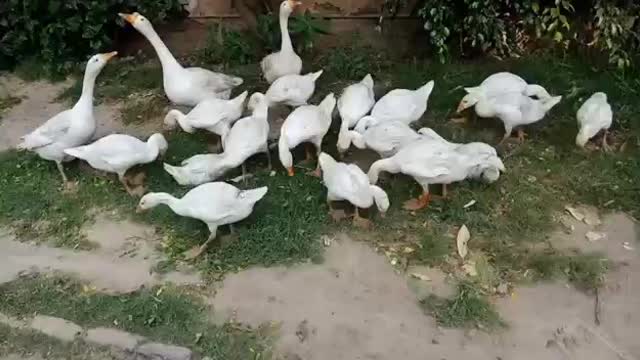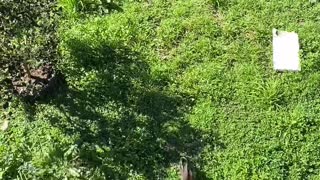Premium Only Content

Feed ducks to keep them healthy|
Raising Ducks: A Primer on Duck Housing, Diet and Health
Learn what ducks eat, and how to ensure they are comfortable and healthy.
Ducks and mud seem to go hand in hand.
My husband and I own a small hobby farm in Virginia and have been raising ducks for the last couple of years. Our very first foray into raising a backyard flock began innocently enough with a trip to the local feed store for hay and feed for our two horses. With our truck loaded with as many bales of hay as it could carry, we headed back home with the feed — plus a cardboard box in which six chicks and two ducklings peeped.
The chicks were a planned purchase. The ducklings, however, were a complete impulse purchase after seeing how adorable they were and being assured by the feed store owner that they could live side by side with our new flock of chickens. Well, he was right. We have been raising both ducks and chickens for several years now, quite successfully, in the same run.
However, food and housing requirements for ducks are a bit different than for chickens. But all co-exist in the same run by day with separate sleeping quarters at night. Here’s how to ensure your ducks are comfortable, healthy and well-fed.
Housing/Pen
Most domestic ducks can’t fly. They were intentionally bred to be heavier than their wild counterparts mainly so they wouldn’t be able to fly away from the farms where they were being raised and also so they would dress out better as table birds. This leaves them extremely vulnerable to predators such as foxes, raccoons and dogs. Ungainly and cumbersome on dry land, ducks aren’t able to escape these predators, so as backyard duck keepers it is our responsibility to provide them with a safe, secure place to live.
Duck housing needs to be secure from predators, but other than that, ducks are extremely cold-hardy so any structure you provide for them doesn’t need to be completely enclosed (as long as it is inside a secure run/pen) and won’t need any type of heat in the winter. Four square feet of floor space per duck should be adequate inside the house as long as they are not confined to it for extended periods of time. Since ducks love both rain and snow, they don’t spend many waking hours indoors.
We converted an old wooden doghouse into a house for our first ducks by cutting a door out of a piece of plywood and attaching hinges and a predator-proof lock. We built a ramp, cut plenty of air vents, covered them with ½” hardware cloth, and built a nesting box on one side. Ducks emit a lot of moisture when they breathe, so adequate ventilation and air flow is very important when you are constructing your house. Any house should be at least three feet tall to provide adequate head room and air flow.
A layer of straw will suffice for bedding and nesting material. Ducks don’t perch like chickens and will nestle down in the straw instead to sleep. The straw should be changed out regularly, but always removed immediately if it is wet or if there is any whiff of an ammonia smell.
A duck nesting box should be approximately 16” square, although in my experience ducks won’t necessarily use it. In fact, our ducks prefer large wooden boxes filled with straw, but they aren’t very concerned about privacy or a dedicated nesting area and seem just as happy making a nest in a corner of their house in the straw.
Pen or yard fencing should be 1” or smaller welded wire fencing and sunk into the ground at least 8” to prevent predators from digging underneath. The top should also be covered. Although ducks aren’t at too much risk from attacks by hawks or other aerial predators, foxes and raccoons can easily scale a fence.
While a pond isn’t necessary for raising happy, healthy ducks, they do need a kiddie pool or other tub in which they can submerge their bodies. Ducks have an oil gland at the base of their tail that is activated as they splash water over their backs. This gland helps distribute waterproofing oils over their feathers as they preen their feathers, so providing them a place to bathe is critical.
Ducks and mud seem to go hand in hand. I have tried many different types of waterers, but the ducks always manage to muddy them. Ducks eat by grabbing a mouthful of food, or a mouthful of mud, bugs and worms, and then dunking their bills into the water and swishing it around, so keeping ducks’ water crystal clear just isn’t possible. The important thing is that the water be refilled daily, kept free of fecal matter and algae and that the waterers be cleaned regularly. We use large rubber tubs for water since they are easy to clean and refill. Whatever you use for ducks’ water, it needs to be deep enough that they can submerge their entire head into it to keep their mucous membranes moist.
Diet
Special waterfowl pellets are available in some areas, but regular chicken layer feed is fine for laying ducks. However, ducks (especially growing ducklings) need more niacin than chickens do, so adding brewer’s yeast to their feed in a 5% ratio is recommended. Ducklings grow extremely fast and the niacin helps their bones develop correctly.
Feed should be set out in wide tubs or containers that can’t be tipped over. We use metal pans and stoneware bowls, setting out several at a time so all the ducks can eat at once. A grown duck will eat 4-6 ounces of feed per day so I try to measure out the correct amount, but that amount varies by time of year (they eat more in the winter, less in the summer when weeds and bugs are more readily available). Water should always be provided near the feed. Leftover feed at the end of day should be discarded if it has gotten wet.
Leafy greens are an important part of a duck’s diet. I start our ducklings off young getting used to cut weeds and grass, lettuce and Swiss chard. Ducks won’t eat wilted greens, so I put the ‘salad’ in their water tub. It stays nice and fresh that way and keeps them occupied dabbling for the leafy treats. Ducks also enjoy fresh peas or corn kernels, cucumber pieces, watermelon and cut tomatoes. Grit (coarse sand or dirt) should always be provided to ducks to assist in grinding the food in their gizzard.
Once your ducks reach laying age (generally around 6 months), crushed oyster shell or eggshell should be provided in a separate container free-choice so each duck can eat what she needs for strong eggshells.
Health
Ducks are generally healthy and hardy. They don’t need vaccinations or annual shots and don’t need preventative worming. They aren’t quite as susceptible to external parasites (such as ticks, lice and mites) as chickens since they spend so much time in the water which drowns any parasites that might be present.
However, there are a few things to watch out for in your backyard flock:
Angel Wing – a non-life threatening condition in which the wing doesn’t lie flat against the body. Caused by overfeeding high protein food which causes the wing to grow too fast, angel wing can be reversed by switching to a lower protein feed, providing plenty of exercise and putting the wing in a sling.
Aspergillosis – Caused by fungal spores, aspergillosis causes heavy, labored breathing, but is easily preventable by removing wet feed and bedding promptly.
Bound Crop – Foreign objects, strings or long grasses can get lodged in the upper part of the digestive system (the crop). The duck’s throat area may look swollen or feel hard. Massaging can help, as can a regimen of vegetable oil to try and break up the mass and allow it to pass.
Botulism – Prevalent in warm weather, botulism thrives in decaying waste or pools of water. It is important to keep water sources clean (we use white vinegar and a scrub brush on the water tubs and pool regularly) because botulism can cause death within hours.
Bumblefoot – Probably the most common affliction of ducks, affecting mainly the heavier breeds. Bumblefoot is an infection that manifests itself in a black scab and swelling on the underside of the foot. It needs to be treated to prevent the infection from spreading and causing potential lameness. Bumblefoot is usually caused by a cut on the underside of the foot, so keeping the duck pen free of sharp stones, branches and other foreign objects is helpful.
Egg Binding – This occurs when a duck is unable to pass an egg. Often it is possible to soak the duck in a warm bath and then apply vegetable oil around the vent to encourage the muscles to relax enough to let the egg out.
Eye Infections – Sometimes rough mating will result in bubbling around the eyes, since the male duck (or drake) grabs the back of the female’s neck where her sinuses are located. Saline rinses can help clear this up as can access to a clean pool or tub of water. Ammonia buildup as well as dust can also cause eye irritations so clean straw or rice hull bedding in the duck house is important.
Scary as some of these conditions sound, in our years raising ducks the only issue we have had to deal with is bumblefoot and that is fairly easy to spot and treat. Lots of preventatives and good duck yard sanitation go a long way towards raising a healthy flock.
Related To:Healthy Home and Home SafetyHomesteading
Home
Outdoors
Gardens
Animals and Wildlife
Now Viewing
A Guide to Duck Houses
Here's six things to consider when building a home for backyard ducks.
By: Lisa Steele
Duck House Ideas
Photo by Lisa Steele
Duck housing can be as simple or as elaborate as you choose. Whether you convert a small doghouse or build a custom shed, the one thing a duck house must be is predator-proof. Domestic ducks move very slowly on the ground and can’t fly, so they are extremely vulnerable to predators—especially at night—and need a safe place to sleep, lay their eggs and maybe even raise ducklings.
Ducks, unlike chickens, don’t need roosting bars and will rarely use nesting boxes, instead preferring to make a nest in one corner of the house on the floor. An old playhouse or a gardening or potting shed works quite well for duck housing. As long as it's fitted with a door and has hardware cloth over any openings, any of these structures will get your ducks' approval.
Some other things to consider:
Size. Before you decide how fancy your duck house will be, figure out how large it needs to be. You should allow for 4 square feet of floorspace per duck. Since ducks typically sleep on piles of bedding on the floor, they need enough room to be able to get comfortable.
Flooring. Duck houses can sit directly on the ground but should have a wooden or cement floor so predators can’t dig underneath to gain access. A piece of inexpensive vinyl flooring over the floor makes for easy clean-up, and also prevents the floor from getting wet if you leave water in the house overnight for your ducks.
Bedding. Pine shavings work fine for bedding, but our ducks prefer straw. Straw has wonderful insulating properties during colder months, keeping ducks warm; it also holds its shape better, so they don’t end up sleeping on the cold wood or cement floor. Straw also doesn’t tend to become sodden like shavings do when wet, and doesn’t harbor mold like hay can. Regardless, wet or soiled bedding should never be allowed to stay in the duck house because mold fungi can lead to aspergillosis, a potentially fatal infection of the duck’s respiratory tract.
Nesting Boxes. As mentioned above, ducks rarely use nesting boxes. If you do decide to include some boxes, they should be at floor level. The boxes should be at least 14 square inches and filled with clean straw. Alternatively, you can put a wooden box on its side in one corner of the duck house and see if your ducks will use it.
Ventilation. The house should be at least 3 feet tall, with vents along the top near the roof to allow for good air flow. Ducks emit lots of moisture when they breathe, and if that moisture can’t escape, it can lead to moldy and mildewed bedding or even frostbitten legs and feet in winter.
The house should also include additional windows with hinged shutters that can be opened or closed as needed, depending on the weather. All vents and windows need to be covered with 1/2-inch hardware cloth to prevent predators from gaining access. It’s best to position windows at least a foot off the ground (or install "shutters") to prevent predators from peeking in and seeing your sleeping ducks. That can unduly stress the ducks and lead to predators working overtime to get in.
Entrance/Exit. The pop door to your duck house should be sufficient for two ducks to enter and exit at once. Ducks often like to push and shove, and can get stuck if the door is too small. The door needs a predator-proof latch on it (remember that raccoons can slide deadbolts and lift latches). A locking eye hook is a good choice for the house door. If the duck house isn’t ground level, a ramp is necessary for the ducks to use to get in and out—and if the ramp is narrow, adding some railings will help the ducks keep their balance and not fall off the sides.
Keeping these various points in mind, you should easily be able to build a simple house or convert an existing structure into a safe, secure house for your ducks.
-
 0:51
0:51
KaisersCorner
3 years agoGerman Shepherd helping feed the ducks
602 -
 0:54
0:54
It's Wild by Gary C Peeples
4 years agoBantam Ducks Feed On Aquatic Life
98 -
 2:03:51
2:03:51
TimcastIRL
11 hours agoTrans Minneapolis Shooter BLAMED Massacre On Mom & Gender Transition | Timcast IRL
206K383 -
 47:29
47:29
Man in America
18 hours agoIT DOESN'T ADD UP: The Trans Shooter's Story Is FULL of Holes
71.5K85 -
 3:59:36
3:59:36
StevieTLIVE
11 hours agoFriday Night Warzone HYPE
50.5K1 -
 3:47:10
3:47:10
SynthTrax & DJ Cheezus Livestreams
1 day agoFriday Night Synthwave 80s 90s Electronica and more DJ MIX Livestream Michael Jackson / AI Art Compilation Edition
57.3K2 -
 1:03:57
1:03:57
Sarah Westall
11 hours agoMara Lago Accord Joins the Fed, Fed Waves the White Flag & more w/ Andy Schectman
38.2K2 -
 2:44:12
2:44:12
I_Came_With_Fire_Podcast
1 day ago*BREAKING* Special Guest Katarina Szulc
47.3K9 -
 3:22:20
3:22:20
megimu32
11 hours agoOFF THE SUBJECT: FAFO Friday! Bodycams & Mario Kart Mayhem!
31.3K5 -
 55:36
55:36
Flyover Conservatives
1 day ago4 Strategies to Create Opportunity from Nothing - Clay Clark | FOC Show
34.6K1